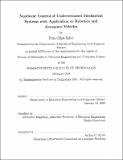Nonlinear control of underactuated mechanical systems with application to robotics and aerospace vehicles
Author(s)
Olfati-Saber, Reza
DownloadFull printable version (13.33Mb)
Other Contributors
Massachusetts Institute of Technology. Dept. of Electrical Engineering and Computer Science.
Advisor
Alexandre Megretski.
Terms of use
Metadata
Show full item recordAbstract
This thesis is devoted to nonlinear control, reduction, and classification of underactuated mechanical systems. Underactuated systems are mechanical control systems with fewer controls than the number of configuration variables. Control of underactuated systems is currently an active field of research due to their broad applications in Robotics, Aerospace Vehicles, and Marine Vehicles. The examples of underactuated systems include flexible-link robots, nobile robots, walking robots, robots on mobile platforms, cars, locomotive systems, snake-type and swimming robots, acrobatic robots, aircraft, spacecraft, helicopters, satellites, surface vessels, and underwater vehicles. Based on recent surveys, control of general underactuated systems is a major open problem. Almost all real-life mechanical systems possess kinetic symmetry properties, i.e. their kinetic energy does not depend on a subset of configuration variables called external variables. In this work, I exploit such symmetry properties as a means of reducing the complexity of control design for underactuated systems. As a result, reduction and nonlinear control of high-order underactuated systems with kinetic symmetry is the main focus of this thesis. By "reduction", we mean a procedure to reduce control design for the original underactuated system to control of a lowerorder nonlinear or mechanical system. One way to achieve such a reduction is by transforming an underactuated system to a cascade nonlinear system with structural properties. If all underactuated systems in a class can be transformed into a specific class of nonlinear systems, we refer to the transformed systems as the "normal form" of the corresponding class of underactuated systems. Our main contribution is to find explicit change of coordinates and control that transform several classes of underactuated systems, which appear in robotics and aerospace applications, into cascade nonlinear systems with structural properties that are convenient for control design purposes. The obtained cascade normal forms are three classes of nonlinear systems, namely, systems in strict feedback form, feedforward form, and nontriangular linear-quadratic form. The names of these three classes are due to the particular lower-triangular, upper-triangular, and nontriangular structure in which the state variables appear in the dynamics of the corresponding nonlinear systems. The triangular normal forms of underactuated systems can be controlled using existing backstepping and feedforwarding procedures. However, control of the nontriangular normal forms is a major open problem. We address this problem for important classes of nontriangular systems of interest by introducing a new stabilization method based on the solutions of fixed-point equations as stabilizing nonlinear state feedback laws. This controller is obtained via a simple recursive method that is convenient for implementation. For special classes of nontriangular nonlinear systems, such fixed-point equations can be solved explicitly ...
Description
Thesis (Ph.D.)--Massachusetts Institute of Technology, Dept. of Electrical Engineering and Computer Science, 2001. Includes bibliographical references (leaves 308-316).
Date issued
2001Department
Massachusetts Institute of Technology. Department of Electrical Engineering and Computer SciencePublisher
Massachusetts Institute of Technology
Keywords
Electrical Engineering and Computer Science.